Native
Exotic
Retinia Guenée (Tortricidae: Olethreutinae: Eucosmini)
Retinia contains 28 described species, most of which occur in the Holarctic region. A few species are known from southeast Asia and one is described from Madagascar. 14 species are known to occur in North America, all of which are native. In much of the literature, Petrova Heinrich is used instead of Retinia. Miller (1978)Miller (1978):
Miller, W. E. 1978. Petrova pitch-blister moths of North America and Europe: two new species and synopsis (Olethreutidae). Annals of the Entomological Society of America. 71: 329-340. provides detailed biological notes and taxonomic accounts for several pine-feeding species. Much of the following summary draws from Miller (1978)Miller (1978):
Miller, W. E. 1978. Petrova pitch-blister moths of North America and Europe: two new species and synopsis (Olethreutidae). Annals of the Entomological Society of America. 71: 329-340..
Species of Retinia are commonly known as pitch-blister moths or pine resin gall moths due to the distinctive patterns of damage they cause on their host plants, most commonly pine (Pinus spp.), but also fir (Abies spp.), larch (Larix spp.), spruce (Picea spp.), and douglas-fir (Pseudotsuga spp.). Several species attain occasional pest status in coniferous plantations.
Most species are univoltine, with adults present in spring and summer, but at least two species (R. albicapitana and R. virginiana) require two years to complete development. Larvae initially feed on needle bases before moving to feed internally on stems as they grow. Larvae form blister- or gall-like structures on stems as a response to exuded resin produced by the stem during feeding. These structures grow as the larva feeds. Larvae appear to be well-adjusted to dealing with resin, as their mandibles do not get gummed up and they have no problem moving around inside these specialized feeding shelters. It is not clear whether overwintering occurs in the larval or pupal stage for univoltine species.
Larvae of pine-feeding species of Retinia species can be separated from other tortricid larvae by two characters: the ventralventral:
lower, to the bottom, on the under side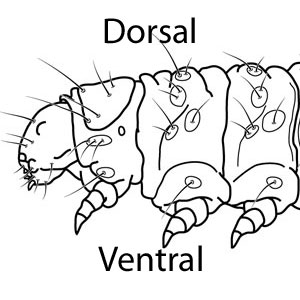 seta group on the prolegs have 4 or 5 setae and the tip of the spinneret is bifurcate in all species except R. resinella (MacKay 1959MacKay 1959:
seta group on the prolegs have 4 or 5 setae and the tip of the spinneret is bifurcate in all species except R. resinella (MacKay 1959MacKay 1959:
MacKay, M. R. 1959. Larvae of the North American Olethreutidae (Lepidoptera). Canadian Entomologist, Supplement 10: 1-338.).
Species identification for most adults is difficult due to similarities in wing patterns and overlapping distributions. A few species, such as R. burkeana and R. picicolana, are highly distinctive, but the rest may require dissection to obtain a species identification. Excluding the aforementioned two species, most Retinia have a relatively homogenous forewing pattern consisting of a red-orange to black ground color overlaid with silver or white fasciaefasciae:
plural of "fascia" . In this regard, they closely resemble species of Rhyacionia, but they tend to have larger, broader forewings and more irregular fasciaefasciae:
. In this regard, they closely resemble species of Rhyacionia, but they tend to have larger, broader forewings and more irregular fasciaefasciae:
plural of "fascia" . Males lack a costal fold, which separates them from the similar-looking Eucopina, which also feed on Pinaceae.
. Males lack a costal fold, which separates them from the similar-looking Eucopina, which also feed on Pinaceae.
Male genitalia are characterized long and slender sociisocii:
a pair of lightly sclerotized setose lobes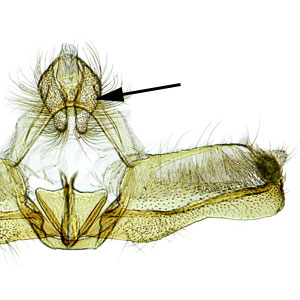 and a deeply invaginated ventralventral:
and a deeply invaginated ventralventral:
lower, to the bottom, on the under side margin of the valvaevalvae:
margin of the valvaevalvae:
plural of "valva" , resulting in a highly constricted neck and a well-developed cuculluscucullus:
, resulting in a highly constricted neck and a well-developed cuculluscucullus:
the distal portion of the male valva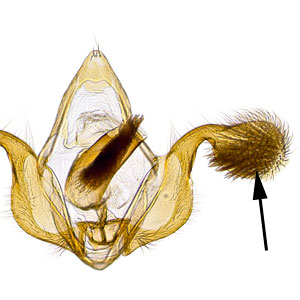 (except in R. gemistrigulana, R. picicolana, and R. pallipennis). Female genitalia are characterized by minor sclerotization of the ductus bursaeductus bursae:
(except in R. gemistrigulana, R. picicolana, and R. pallipennis). Female genitalia are characterized by minor sclerotization of the ductus bursaeductus bursae:
a membranous tube connecting the ostium bursae to the corpus bursae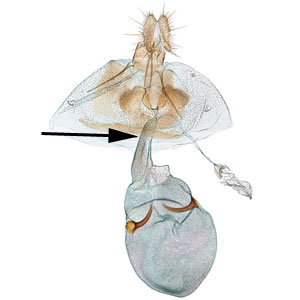 and two cone-like signasigna:
and two cone-like signasigna:
plural of "signum"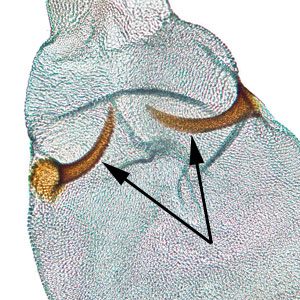 .
.
View full screen host table here